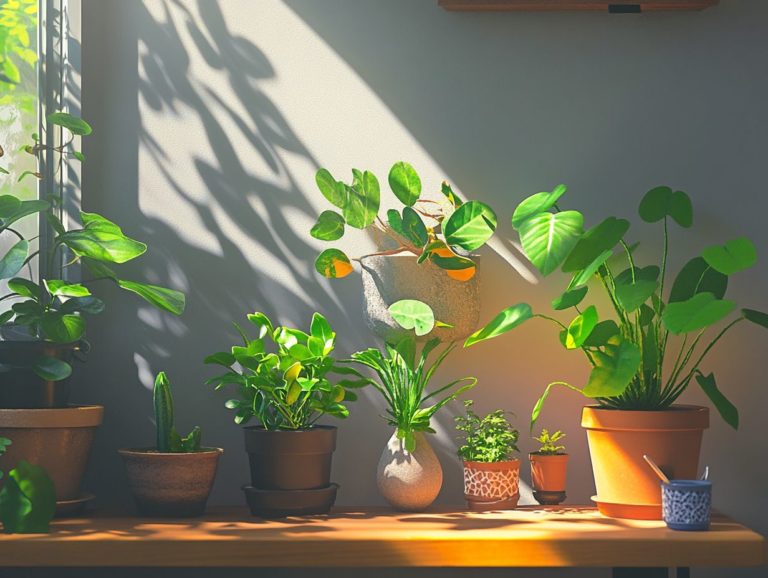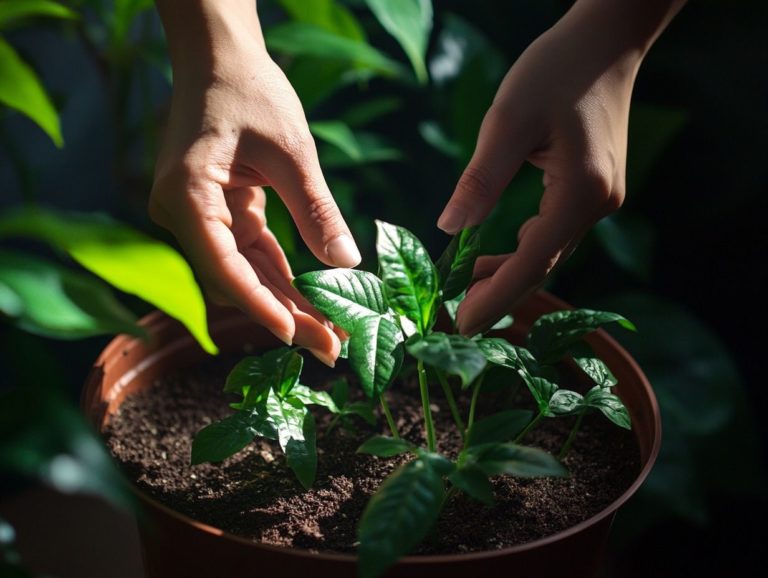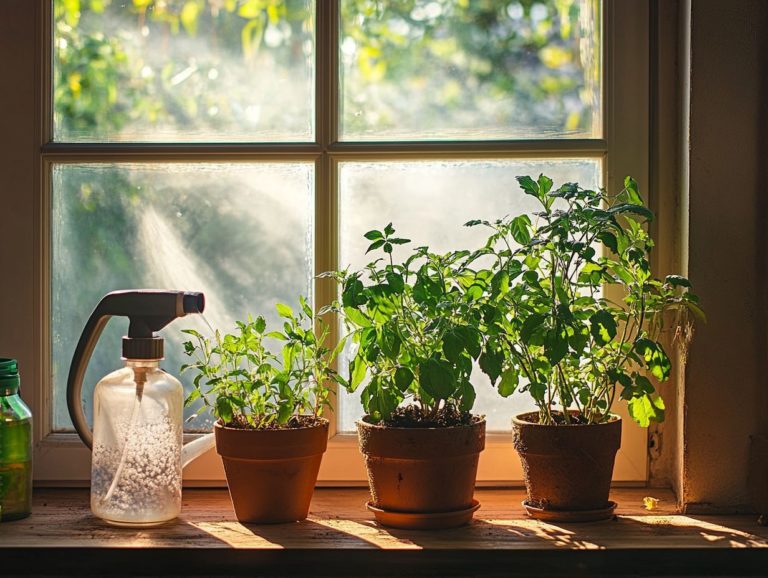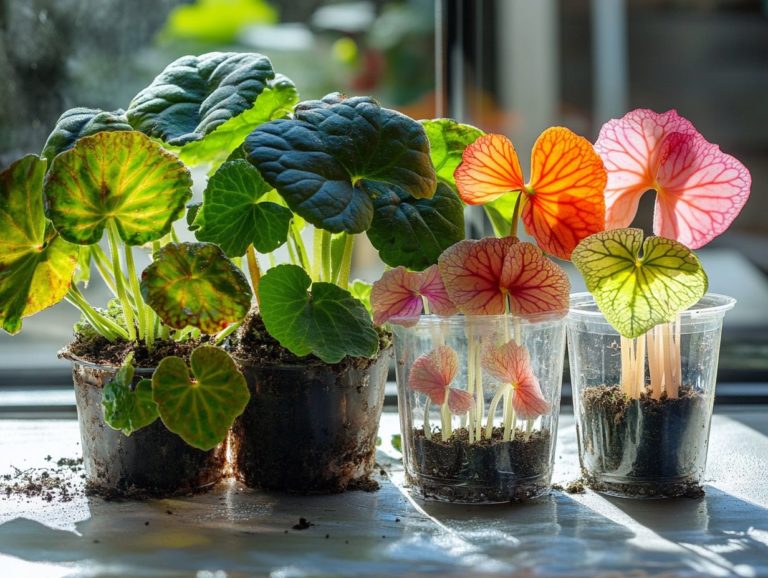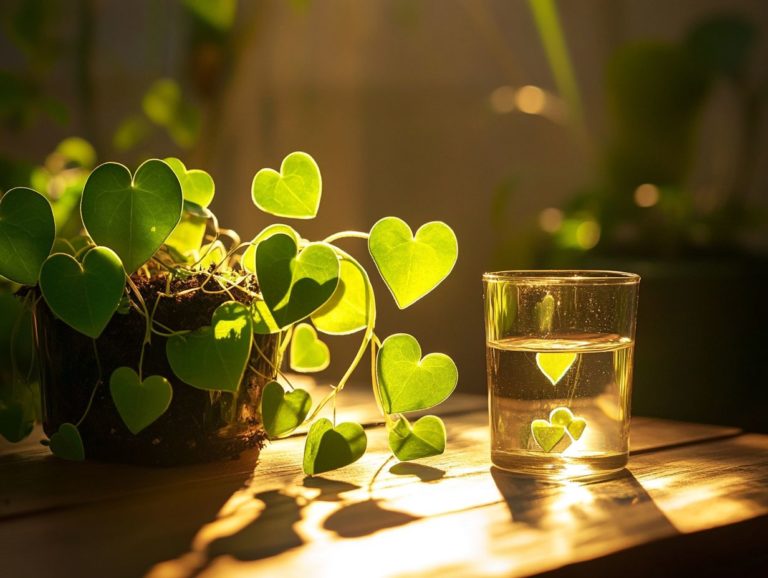The Best Practices for Propagating Carnivorous Plants
Propagation offers a thrilling avenue to expand your collection of carnivorous plants while sharing their unique allure with others.
Get ready to explore exciting methods of propagation! This guide delves into various methods, including leaf cuttings, division, and seed germination.
You’ll discover best practices, such as selecting the optimal timing and supplying essential nutrients. Plus, you’ll steer clear of common pitfalls that could impede your success.
Whether you re just starting out or you re a seasoned enthusiast, these insights will empower you to cultivate vibrant, healthy plants that thrive.
Contents
Key Takeaways:
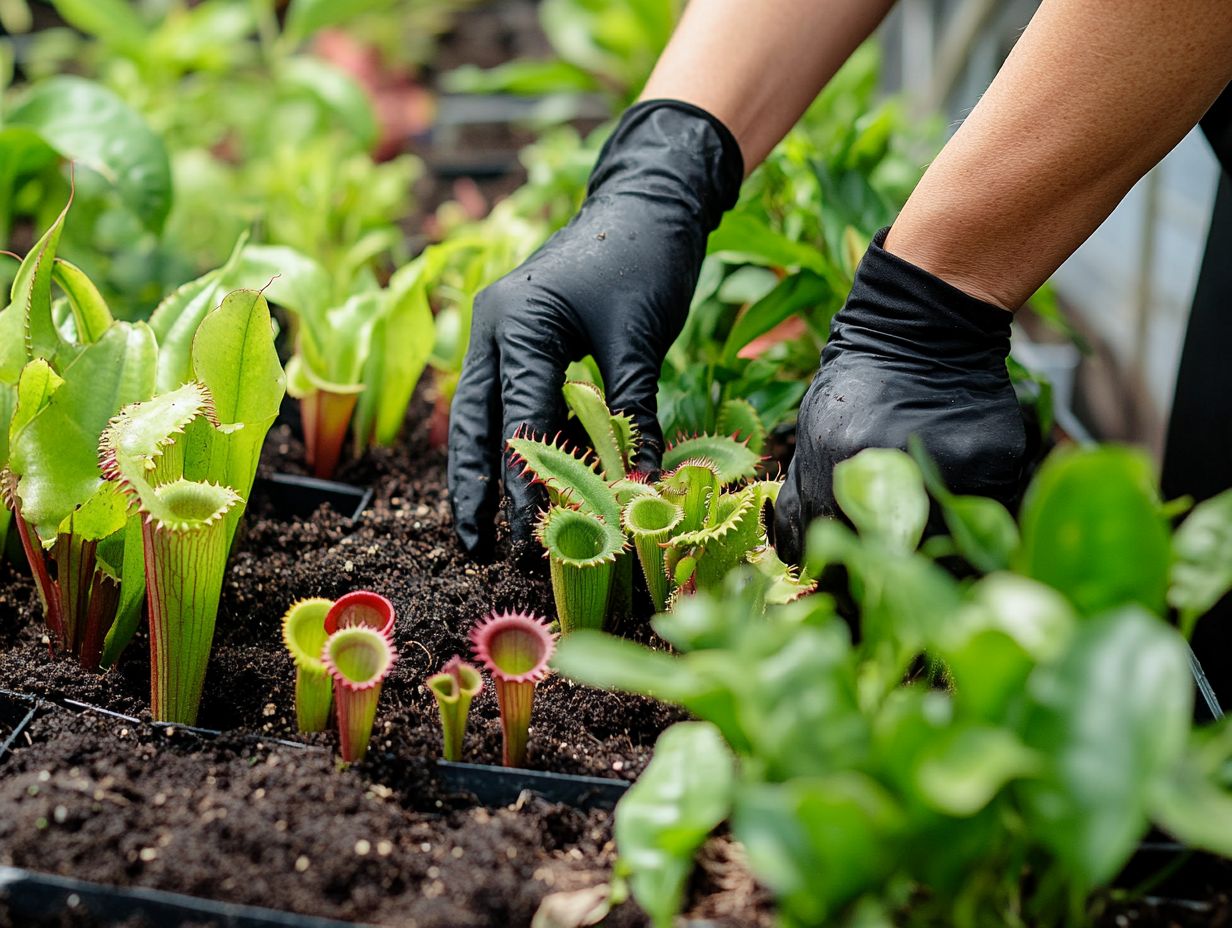
- Choose the right time and conditions for propagating carnivorous plants to ensure optimal success.
- Provide adequate nutrients and water to foster healthy growth and development of your propagated plants.
- Prevent pests and diseases by practicing proper hygiene and implementing pest control measures to protect your carnivorous plants.
What is Propagation?
Propagation is the art of creating new plants from various sources, including seeds, cuttings, or divisions. This process holds particular significance for specialized species like carnivorous plants, such as the renowned Venus flytrap (Dionaea muscipula) and Sarracenia.
By mastering the intricacies of propagation, you can significantly elevate your success in cultivating these fascinating species. With this knowledge, you can maintain vibrant populations that flourish in both indoor settings and bog gardens, ideally nestled on a sunlit windowsill.
Methods of Propagation
There are various effective methods of propagation for carnivorous plants, each specifically designed to cater to the unique needs of species like the Venus flytrap and Sarracenia.
Familiarizing yourself with these techniques leaf cuttings, division, and seed germination will enhance your ability to successfully cultivate and expand your collection.
Remember to provide optimal conditions, such as boggy soils soils that retain moisture, mimicking the natural habitat of carnivorous plants and special soil made for acid-loving plants to ensure your plants thrive.
Leaf Cuttings
Want to know how to clone your favorite plants? Leaf cuttings offer a remarkable way for you to propagate different types of carnivorous plants, enabling you to effortlessly clone your most successful specimens.
By thoughtfully selecting healthy leaves from a parent plant and placing them in moist compost, you can nurture new growth and broaden your collection with captivating species like the Venus flytrap.
The ideal time for this endeavor is usually during the growing season when your parent plant is in full swing, producing fresh foliage.
Opting for peat-free compost is highly advisable; it s sustainable and excellent for drainage.
It’s essential to keep humidity levels in check. You might consider covering your cuttings with a plastic bag or a dome to create a cozy greenhouse effect.
Regarding watering, using rainwater or distilled water is the way to go, as it sidesteps the harmful minerals often found in tap water. This ensures robust root development and vibrant growth for your fascinating plants.
Division
Division is a highly effective propagation method that allows you to separate a mature carnivorous plant into smaller sections, each ready to be planted individually for optimal growth.
This technique shines particularly well with plants like Sarracenia, which thrive in moist, boggy soils when properly divided and cared for.
Timing is everything when it comes to division; early spring is often seen as the ideal season, as plants are emerging from dormancy and eager to grow.
When you perform the division, remember to handle the roots gently to minimize stress. Once you ve made the divisions, the right care becomes essential.
A thoughtful blend of organic fertilizer and special soil made for acid-loving plants can significantly boost soil nutrient levels, fostering healthy root development.
Watering needs to be consistent yet delicate keeping the soil damp but never waterlogged will support the rejuvenation of these newly separated plants.
This careful approach ensures they can reestablish quickly and thrive in their new environments.
Start your propagation journey today and watch your collection flourish!
Seed Germination
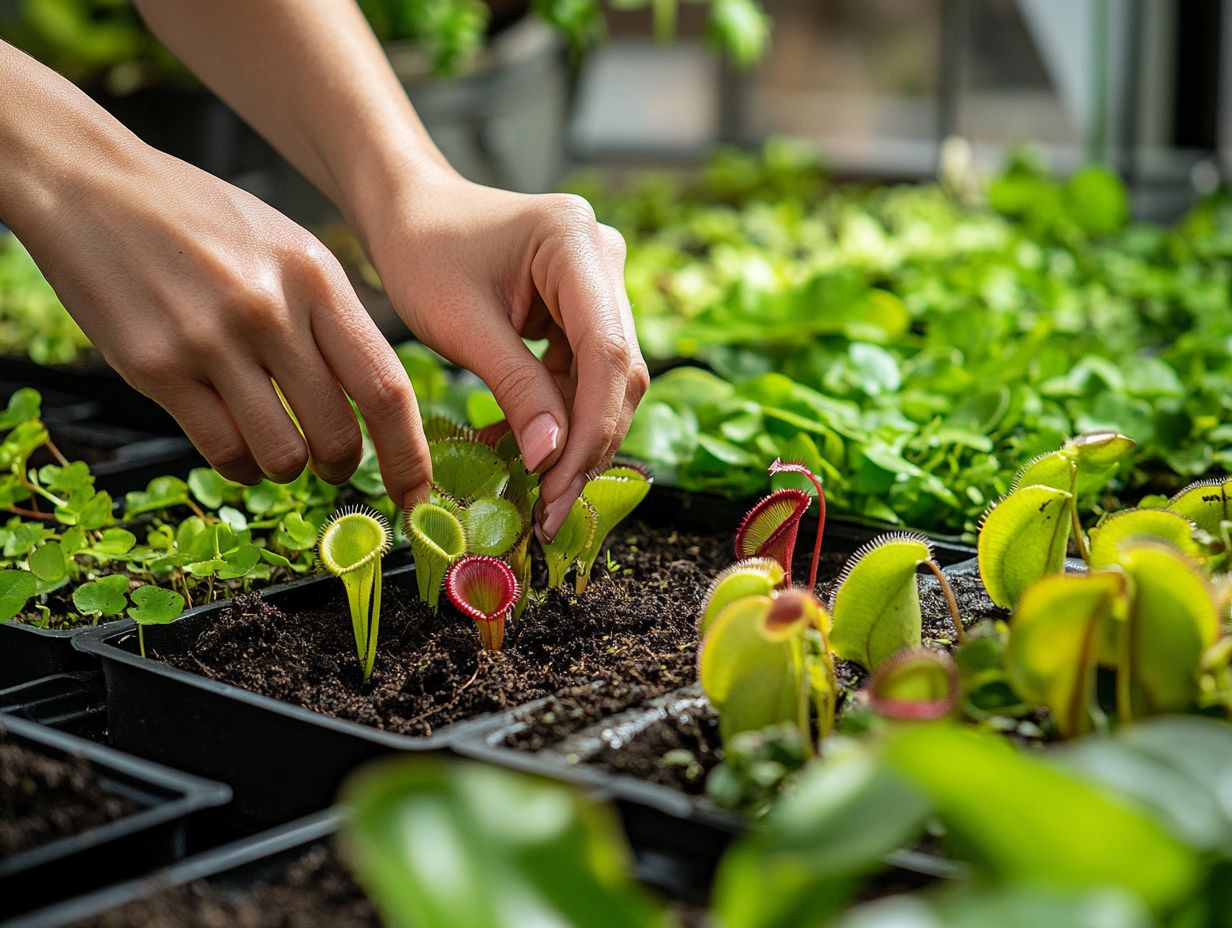
Seed germination is a captivating journey that transforms tiny seeds into thriving carnivorous plants! This process demands specific conditions to sprout seeds into vibrant, healthy specimens. Mimic their natural environment, optimizing factors like temperature, humidity, and light, especially for iconic species like the Venus flytrap and Sarracenia.
To kick things off, collect seeds from mature plants, ensuring they re fully developed for the best chances of germinating. After gathering your seeds, a brief soak can help jumpstart the germination process.
These exceptional plants thrive in a moist compost blend that retains humidity, which is vital for germination. Adequate moisture encourages the seeds to swell and break dormancy.
Keep humidity levels high by using a clear cover or propagator. This creates a microenvironment that mimics bog conditions, crucial for the seeds of these species. Once germination occurs, pay close attention to lighting and watering techniques to ensure your seedlings grow strong, helping them flourish as they transition into robust plants.
Best Practices for Growing Carnivorous Plants
To successfully grow carnivorous plants, adhere to several best practices that promote healthy growth and resilience against common challenges. Choose the right time and conditions, ensure adequate nutrients and water, and implement effective pest control measures to significantly increase your plants’ chances of thriving. This applies whether you’re working with the iconic Venus flytrap or various Sarracenia species.
Embrace these strategies and watch your garden flourish with these fascinating botanical wonders.
Choosing the Right Time and Conditions
Choosing the right time and conditions for growing carnivorous plants is essential for maximizing success rates and ensuring robust growth. Factors such as seasonal changes, lighting conditions, and the dormancy periods (a period when the plant is not actively growing) of these unique plants are vital, especially for species like the Venus flytrap, which requires specific temperatures and light exposure to thrive.
Understanding the life cycles of these captivating plants enables you to time your propagation efforts impeccably. Ideally, spring is your golden window for introducing cuttings. The longer daylight hours stimulate growth while temperatures hover between 70-80 F, creating an ideal nurturing environment.
Maintaining the right moisture levels is key. These plants flourish in consistently damp conditions without becoming waterlogged. Ensure they receive adequate sunlight exposure around 12-16 hours daily to support photosynthesis and encourage healthy root development.
By paying attention to these factors, you can achieve remarkable success in plant care, leading to flourishing growth and vibrant displays of these fascinating species.
Providing Adequate Nutrients and Water
Providing adequate nutrients and water is essential for your success in growing carnivorous plants. Utilize organic fertilizers and keep the compost consistently moist to significantly enhance the health of captivating species like the Venus flytrap and Sarracenia during their critical growth phases.
To nourish these intriguing plants, consider options such as fish emulsion or compost teas. These organic alternatives deliver essential nutrients without the harsh chemicals often found in synthetic fertilizers. Not only do these choices improve soil fertility, but they also foster a balanced ecosystem tailored to the unique needs of these species.
When it comes to watering, use rainwater or distilled water. Tap water frequently contains minerals that can be detrimental to carnivorous plants. To maintain the ideal moisture level in your compost, check regularly and employ a layering technique: a top layer of sphagnum moss can help retain water while preventing algae growth.
Don’t miss the perfect time to plant your seeds this spring! Start your carnivorous plant adventure now and watch your garden thrive!
Preventing Pests and Diseases
Preventing pests and diseases is essential for maintaining the health of your carnivorous plants during propagation. By implementing effective pest control measures, such as introducing beneficial insects (insects that help control pests) like Phytoseiulus persimilis, you can protect your plants from common threats and ensure they thrive in conditions that closely mimic their natural bog habitats.
Regularly monitoring for signs of infestations like aphids, mealybugs, and spider mites allows for early intervention. Consider utilizing sticky traps to catch these unwanted visitors before they have a chance to spread.
Maintaining optimal humidity and light levels enhances growth and minimizes stress, making your plants less susceptible to disease. Soil health is also crucial; using sterile, well-draining mediums can significantly reduce the risk of fungus problems.
By combining these preventive measures with targeted treatments, such as insecticidal soaps or neem oil, you can create a protective environment that fosters robust and vibrant growth in your carnivorous plants.
Common Mistakes to Avoid

Avoiding common mistakes is crucial for anyone aiming to successfully cultivate carnivorous plants. Even minor oversights can lead to considerable setbacks in plant health.
For instance, overwatering or using the wrong soil types can create unfavorable conditions for species like the Venus flytrap and Sarracenia. This can stunt their growth and complicate your propagation efforts.
Overwatering
Overwatering is a common pitfall that can drastically affect the health of your carnivorous plants during propagation. It can potentially lead to root rot and other complications. Understanding the moisture needs is vital for your plants health!
One key indicator of overwatering is the yellowing of leaves or a mushy texture, signaling that the roots are gasping for air. To avoid these issues, using well-draining compost is essential, as it allows surplus moisture to escape and fosters healthier root systems.
Regularly checking moisture levels helps you establish an appropriate watering routine. Water only when the top inch of soil feels dry to the touch. Keep this in mind, and you’ll soon be the proud caretaker of vibrant, thriving carnivorous plants!
Using the Wrong Soil
Using the wrong soil can be a significant setback in your quest to propagate carnivorous plants. Without the right drainage and acidity, their growth could be stunted. It’s essential to choose a suitable mix, like peat-free compost or ericaceous compost (a soil mix suitable for acid-loving plants), to support species such as the Venus flytrap and Sarracenia.
These remarkable plants thrive in nutrient-poor environments, which means conventional garden soil is a no-go. Its tendency to retain too many nutrients and moisture is unsuitable. For optimal growth, create a specialized soil mix by blending sphagnum moss, sand, and perlite. This combination facilitates effective drainage while ensuring proper aeration.
Keeping an eye on the pH level is crucial, too it should ideally fall between 4.5 and 5.5, closely resembling their natural habitat. This attention to detail provides the right conditions for these captivating species to flourish. Regularly checking the soil’s consistency and making necessary adjustments can significantly elevate your propagation success.
Tips for Successful Propagation
To successfully propagate carnivorous plants, a few key tips can boost your gardening skills. Adjust factors like light, temperature, and humidity to fit the needs of your plants.
Each species has unique needs. For example, some prefer a wetter environment, while others thrive in drier conditions.
Regularly check your plants’ health. This lets you adjust watering schedules and light exposure as necessary.
Using techniques such as cuttings or seed stratification can improve your success rate. Seed stratification is a method to simulate the natural conditions that help seeds germinate.
Pay attention to details. Adjust your care methods as your plants grow to ensure they stay healthy and strong.
Frequently Asked Questions
What are the best practices for propagating carnivorous plants?
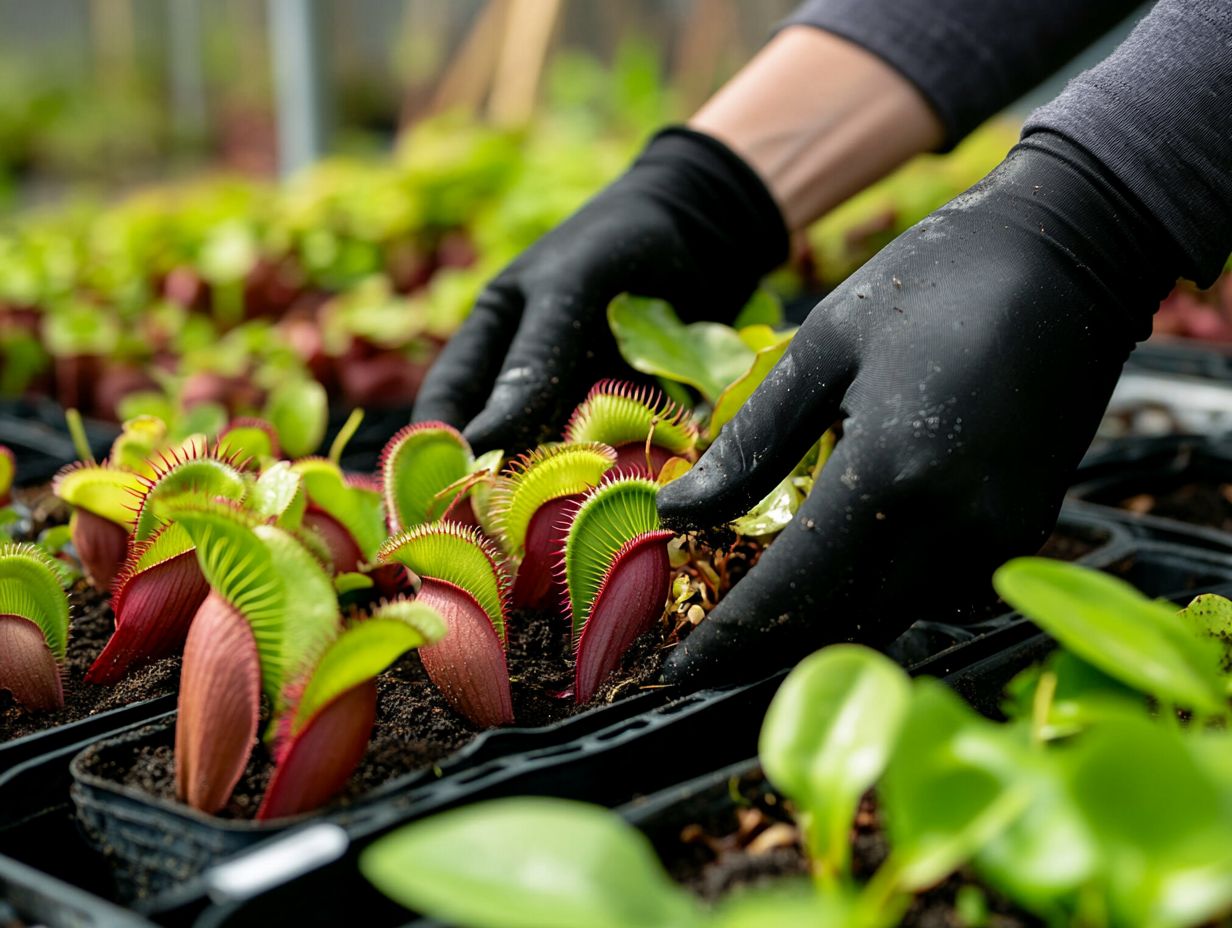
The best practices include using sterile tools, providing proper light, and choosing the right potting mix. Research specific methods for each type of carnivorous plant.
Why is it important to use sterile tools and materials?
Sterile tools prevent disease and help your new plants start healthy. Carnivorous plants are sensitive to bacteria and fungi, so keep everything clean!
What lighting and temperature do carnivorous plants need?
Carnivorous plants need bright, indirect light and warm temperatures. Use fluorescent or LED lights, and consider a heating mat for warmth.
Is a specific potting mix necessary?
Yes, use a specialized potting mix that is low in nutrients and drains well. Adding perlite or sand can improve drainage.
What methods are recommended for propagation?
Methods include leaf cuttings, division, and tissue culture. Choose the best method based on your specific plant.
How long does propagation take?
The time varies by method and plant type. Leaf cuttings can produce new plants in weeks, while tissue culture may take months. Be patient and care for your plants!

